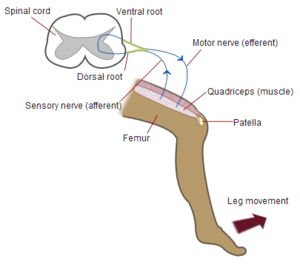Westphal's sign
Westphal's sign is the clinical correlate of the absence or decrease of patellar reflex or knee jerk. Patellar reflex or knee jerk is a kind of deep or stretch reflex where an application of a stimulus to the patellar tendon such as strike by a solid object or hammer caused the leg to extend due to such stimulus causes the quadriceps femoris muscle to contract.
| Westphal's sign | |
|---|---|
 | |
| Patellar tendon reflex arc | |
| Differential diagnosis | Peripheral nerve disease, Motor cortex lesion |
It is named for Carl Friedrich Otto Westphal (1833-1890).[1][2]
Associated conditions
Westphal's sign has a clinical significance used in determining neurodisorders or diseases such as:
- receptor damage, peripheral nerve disease, involving the dorsal(sensory) columns of the spinal cord and cerebellar lesions
- lesions present within the motor cortex of the brain or the pyramidal tracts which it combined with muscular spasms
- complete interruption of sensory and/or motor impulse transmission in the femoral nerve
gollark: The trouble is that you probably also need people to do, well, thinky stuff, which slaves can't really manage. If you want your slaves to be able to give you nice things like cars and smartphones.
gollark: Although if you want to maintain good current quality of life for *you* via slavery you'll need most of this infrastructure anyway.
gollark: Since nowhere has ALL the stuff you need you need a ton of transportation.
gollark: But then you have to locate factories in places with the right minerals.
gollark: 2% or 0.5% efficiency or something, but they conveniently store to chemical energy
References
- synd/945 at Who Named It?
- C. F. O. Westphal. Über einige durch mechanische Einwirkung auf Sehnen und Muskeln hervorgebrachte Bewegungs-Erscheinungen. Archiv für Psychiatrie und Nervenkrankheiten, Berlin, 1875, 5: 803-834.
- The Principles of Physiology Jensen, David Ph.D., Appleton-Century-Crofts, New York.1976
This article is issued from Wikipedia. The text is licensed under Creative Commons - Attribution - Sharealike. Additional terms may apply for the media files.